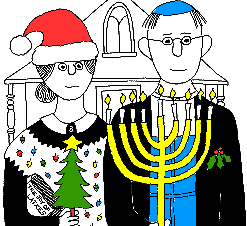CLAL on Culture Archive
Welcome to CLAL on Culture where you will find the latest thoughts and reflections by CLAL faculty and associates on contemporary culture: high and low, material and etherial, trendy and retro, Jewish and otherwise. Every other week you will find something new on this page.
To access the CLAL on Culture Archive, click here.
Our authors are especially interested in hearing your responses to what they have written. So after reading, visit the Clal on Culture Discussion Forum where you can join in conversation with CLAL faculty and other readers.
To join the conversation at CLAL on Culture Talk, click here.
It's in the Cards: Embracing the Sacred Ambivalence of Interfaith Holiday Greetings
By Rabbi Brad Hirschfield
A recent article in The New York Times described a best-selling trend unfolding on the most-used site on the World Wide Web. The site is Blue Mountain Arts, and the trend is toward "interfaith" electronic greeting cards. These cards feature a blend of Hanukkah and Christmas images, and, according to the article, 1,000,000 have already been sent.
My personal favorites include a card in which Rudolph the Reindeer's antler-points have been converted in a fully kindled menorah, and another card in which two Santas approach one another. The first says "Merry Christmas"; the second removes his hat to display a yarmulke, and says "Shalom."

(Copyright © Blue Mountain Arts)
It's not that I am completely comfortable with these cards. I'm not. At the same time, I know that they deserve more than the two typical responses that I usually hear about such phenomena. The first response is that it's "disgusting" or "insulting." The second response is that "it's just fine, it's okay, what's the big deal?"
It seems to me that these cards deserve a more nuanced response. A response that embraces the ambiguities that these cards invoke in me, with the awareness that such ambiguity is sacred. A response that comes from an awareness of just how complex our identities are at the dawn of a new millennium-identities as Jews, Americans and human beings. A response that comes from the complexity that the sacred always implies.
In fact, the cards themselves are complex and multi-faceted in the meanings that they transmit. Thirty, 40, 50 years ago, most of the Jews who were putting up Christmas trees and sending Santa cards were walking away from Hanukkah. The observance of one holiday replaced the observance of the other. These cards do just the opposite. The Jewish sender's basic message is that, "underneath it all, I want you to know that I'm Jewish. I am not throwing away my Jewishness. I'm relocating it, right on Rudolph's head."
I know that some will call this a dangerous form of syncretism, an unacceptable fusion of differing systems of belief. But it is worth bearing two things in mind. First, if we get rid of every ritual that was created by an act of blending, we would say farewell to a long list of "purely Jewish" practices, including the Hanukkah menorah itself! Second, we need to ask ourselves why we are so much more anxious about this phenomenon and blending than are our Christian counterparts. In the end, who is co÷pting whom here? Could it be that we trust the vitality and attractiveness of "our culture" less than they do theirs? If so, then our problem is less with the individuals sending these cards than with our own institutions and the experiences that they are providing.
Maybe, just maybe, on this one issue, Jews and Christians have gotten to a place of such mutual respect and affection that some of us see the opportunity to celebrate some part of this season beyond the usual boundaries. Could these folks be telling us that they want to affirm something that is not necessarily their own, but is nonetheless a piece of who they are?
I don't know the answers to these questions, but I think that we must embrace such ambivalence. During a season that is cold, wet, and dark, we could take a moment to embrace the human endeavor to bring a little more heat, and a little more light, into the world. That is the path to the sacred.